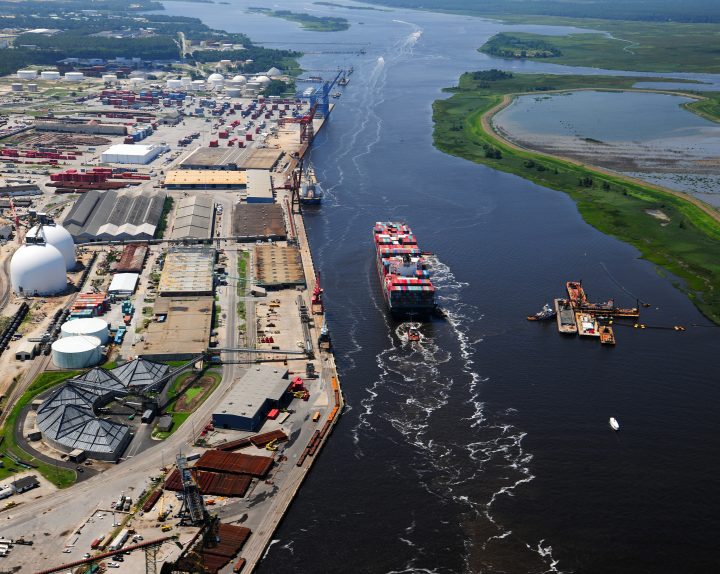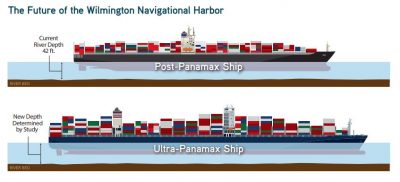
First in a series
This story has been updated to correct a misstatement regarding the Wilmington port’s 2017 cargo statistics.
Supporter Spotlight
WILMINGTON – The Wilmington Harbor Navigation Project is the first in the United States to be funneled through a national review process that gives ports more flexibility in building their projects.
Ports are allowed under the amended Section 203 of the Water Resources Development Act signed into law a year ago by President Trump to kick off projects more expeditiously by paying for their own feasibility and environmental studies rather than waiting for federal funding.
Under Section 203, nonfederal projects have to receive federal authorization and go through the National Environmental Policy Act, or NEPA, process in order to receive federal funds.
As it stands, the North Carolina State Ports Authority’s draft feasibility study must be heavily revised before it would pass muster, according to a federal review of the study.
The feasibility study and the process under which it was conducted are also being criticized by at least one beach town questioning how the proposed project to widen and deepen the harbor channel might affect its beaches.
Supporter Spotlight
‘Needs significant revisions’
Assistant Secretary of the Army for Civil Works R.D. James would not likely make a “positive determination of project feasibility” based on the current draft study, according to the secretary’s office and Army Corps of Engineers’ headquarters staff.

Without James’ recommendation for approval by Congress, the project cannot move forward.
His office in July released a review summarizing the ports’ feasibility study/environmental report as one that needs “significant revisions before it would be considered to be legally and policy sufficient.”
The 15-page review details deficiencies in the ports authority’s report, including the lack of a thorough economic analysis.
“North Carolina Ports is in the process of writing its comments to the Office of the Secretary of the Army for Civil Work,” Bethany Welch, the ports’ senior manager of communications and business outreach, said in an email.
The draft feasibility study calls for deepening the main shipping channel through the Cape Fear River from 42 feet to 47 feet and the ocean entrance to the river from 44 feet to 47 feet. The plan also recommends widening the channel in multiple areas.
Those new depths and widths would allow the Wilmington port to remain competitive with other East Coast ports by making room for larger container ships coming to the East Coast from Asia.
Ports officials say the changes would accommodate vessels that can carry 14,000 20- by 8-foot shipping containers.
Ships of this size can now be navigated through the Panama Canal, a newly expanded portion of which opened in June 2016.
In order for these larger ships to call at the Wilmington port, the width of the port’s turning basin also needs to be expanded by 124 feet, ports authority officials say.
The North Carolina Division of Coastal Management earlier this year rejected the ports authority’s application for a Coastal Area Management Act major permit modification to widen the turning basin.
The ports authority appealed the denial and, last April, the Coastal Resources Commission granted a variance for the project, which includes dredging 17.76 acres designated primary nursery area, or PNA, and the excavation of a little more than one acre of coastal wetlands.
In its variance request, the ports authority said that without the turning basin expansion, the Wilmington port “would lose the ability for North Carolina to maintain presence in the global container shipping market,” which would, in turn, adversely impact the state’s economy.
That argument is one of several points of concern discussed in the federal policy review assessment, which states that the planning objectives in the draft feasibility study are unclear and “could potentially lead to the pre-selection of an alternative plan.”
The review goes on to state that the ports authority’s feasibility study lacks documentation from shipping companies supporting the argument that those companies would not use the port.
The study appears to overestimate future shipping projections from the Asia route, according to the review.
The ports’ economic analysis assumes that by 2025, 272,615 vessels from the Asia route would use the Wilmington port. That’s nearly double the number of ships – 179,713 – from non-Asia routes projected to call at the port within that same time period.
The Waterborne Commerce Statistics Center, or WCSC, indicates that the Wilmington port handled 178,865 TEUs, or twenty-foot equivalent units — a measure of shipping container volume, during 2017.
The ports authority’s study projects a 137% increase in shipping traffic between 2017 and 2025.
“It appears that the commodity forecast has been significantly overestimated,” the review states. “Correcting that error would result in a dramatic reduction in project benefits.”
The review also calls into question the study’s assumption that 100 percent of the shipping fleet from Asia will transition to the largest shipping container vessels, a presupposition that the review says is “unrealistic.”
Environmental considerations
The feasibility study also lacks information about alternative dredging depths, the potential implications of those alternative depths to the environment, and the effects of sea level rise.
Maintaining the port for the next 50 years to accommodate larger ships from Asia “seems to be a corporate objective rather than a planning objective,” and that “it seems that depths between 42’ and 46’ were eliminated from consideration due to flawed objectives,” according to the assessment.
Jerry Diamantides, senior economist with contractor David Miller & Associates, told the authority’s board of directors in August that the feasibility study showed that deepening the channel to 47 feet would have only minor environmental impacts.
But the study should look beyond channel depth increments and include detailed alternatives such as relocating facilities, according to the federal assessment.
Federal reviewers also said the report understates environmental effects of the project, including its impact on river bottom habitats. The study needs to more accurately describe the long-term or permanent effects the project will have on that habitat, according to the assessment.
The port authority’s environmental study also needs to fully integrate impacts of sea level rise, including future changes in water levels, saltwater intrusion, and induced flooding.
It is unclear when the ports authority will turn over a revised study to Washington. Ports authority officials have said they hope James will recommend the project to Congress before November 2020.
Next: Lack of public input at issue







